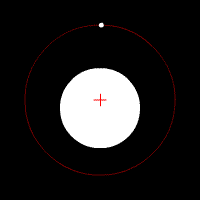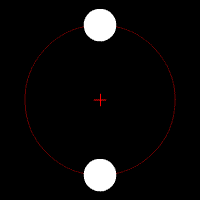Geocentrism only requires that we be a little bit wrong about gravity. And the atom proves how easy this could be the case.
How do we know that heliocentrism is the "correct" view for how the universe works? Quite simply, it's because it predicts orbits better than the geocentric models did. But that only became the case once Kepler discovered that orbits were not circular (as all geo- and heliocentric models had assumed until then), and then he applied the results of his calculations (using Tycho Brahe's observations) to Copernicus' heliocentric model. He could just as easily have applied them to Ptolemy's or Brahe's geocentric models instead, though; would have given us a more complex model, but that alone doesn't prove it's wrong.
So what does the atom have to do with this? The Bohr model is still taught today in schools despite everyone knowing full well these days that it does not accurately represent atoms. What it does do, however, is provide a simple and convenient model that explains covalent bonds, energy emissions and absorptions as electrons "jump orbits", etc. Which is why it's still taught in schools today. Just like Kepler's heliocentric model, it's the simplest explanation of how, when, and why these things will happen.
And yet we know it's wrong. We know electrons don't orbit atoms in such neat little circles, but rather dash around haphazardly in a chaotic cloud. (Thanks, quantum mechanics!)
So the Bohr model proves that you can have a simple model for how things work even though it represents those things completely wrongly; why can't the same be said for Kepler's heliocentric model?
Because we also know gravity does work the way Kepler's model requires. And our understanding of gravity is observed consistently throughout the universe, right? Well, no, actually -- astronomers have had to "invent" the concept of "dark matter" (stuff with gravity that we cannot see or touch but trust us it's totally there!) to account for all their calculations about gravity being wrong!1
So for the geocentric concept of the universe to be right, we only have to be wrong about a model that we've stood behind for a mere fraction of the time -- the Ptolemaic model was the model for the universe for around 15 centuries, and successfully resisted the Copernican heliocentric model because the latter was no more accurate; it was Kepler's heliocentric model that finally figured it all out, and only usurped it around 5 centuries ago.
We're wrong about the Bohr model despite it having its benefits, so why can't we be wrong about Kepler's model, too?
Depending on your world, you have a couple of ways to go if you want a geocentric universe:
- A magical force that produces the spheres-on-spheres (actually ovoids, as Kepler's proven) necessary for the Ptolemaic model
- "Dark matter" is real -- and it's actually the aether that made up the aforementioned spheres-on-spheres
- Ptolemy was right about the spheres-on-spheres, but not their composition, and they are in fact binary systems of planets/moons/the sun with a companion dark matter body, all orbiting around Earth because... well I haven't quite figured this part out yet...
Disclaimer before the comments start: I actually do not believe the conclusions postulated above. This is merely an attempt to answer the question as asked by presenting a somewhat plausible explanation for a geocentric universe given modern scientific concepts by first showing how science has progressed in the past and extrapolating that it could continue in the future by disproving what we "know" today just like it's disproven much of what we "knew" in the past. I've treated a few scientific concepts with a certain light brevity that would not fly in any scientific circles solely because presenting what is effectively an anti-scientific model as "reality" requires first putting science in the backseat, at least a little bit.
This is, after all, all for fiction.
1 This is, amazingly, only a slightly simplistic representation of how "dark matter" came to be conceived!



